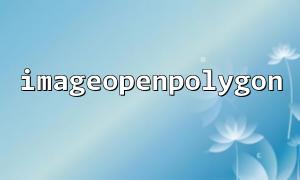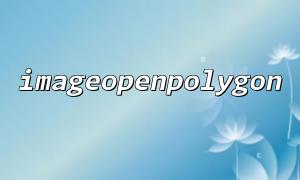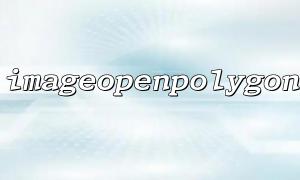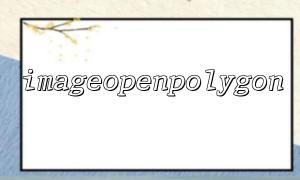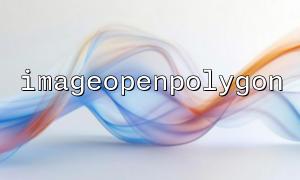In PHP, imageopenpolygon() is a very practical function that can be used to draw open polygon lines. This function performs well when drawing in small scales, but when it involves a large number of points or large scale drawing tasks, its performance bottleneck gradually appears. This article will explore some ways to improve the performance of imageopenpolygon() in large-scale drawing.
imageopenpolygon() accepts an array of points, usually a one-dimensional array, like [x1, y1, x2, y2, ..., xn, yn] . When generating these point data:
Try to pre-create all points and avoid dynamic calculations when calling imageopenpolygon() .
Make sure the array is compact and has no extra null values or duplicate points.
// Not recommended:Dynamically generated points
$points = [];
for ($i = 0; $i < 1000; $i++) {
$points[] = rand(0, 500);
$points[] = rand(0, 500);
}
imageopenpolygon($image, $points, count($points) / 2, $color);
// recommend:Fixed array prepared in advance
$points = generatePoints(); // generatePoints()Return an optimized one-dimensional array internally
imageopenpolygon($image, $points, count($points) / 2, $color);
If there are a lot of duplicate or similar polygons in your drawing, consider:
Caches the generated dot array to a file or memory (such as using Redis).
Reuse this data every time you draw, rather than regenerate each time.
$cacheKey = 'polygon_points_large';
$points = apcu_fetch($cacheKey);
if ($points === false) {
$points = generateLargePolygonPoints();
apcu_store($cacheKey, $points);
}
imageopenpolygon($image, $points, count($points) / 2, $color);
Note: Using APCu cache requires the server to enable APCu extensions.
When drawing at a large scale, not necessarily every detail needs to be accurately displayed. Appropriate simplification of the set of points can greatly improve performance:
Use decimation algorithm to reduce the number of points.
The sampling rate is dynamically determined based on the zoom level.
Simple point simplification example:
function simplifyPoints(array $points, int $threshold = 5): array {
$simplified = [];
for ($i = 0; $i < count($points) - 2; $i += 2) {
if ($i % ($threshold * 2) == 0) {
$simplified[] = $points[$i];
$simplified[] = $points[$i + 1];
}
}
return $simplified;
}
$originalPoints = generateVeryLargePolygon();
$points = simplifyPoints($originalPoints, 10);
imageopenpolygon($image, $points, count($points) / 2, $color);
Although the GD library is built into PHP and is easy to use, the performance of GD may be insufficient under extreme drawing requirements. Consider:
Using Imagick (PHP extension based on ImageMagick), it performs better on large-scale graphics processing.
In combination with the CLI method, call a special drawing program (such as calling the ImageMagick command through shell_exec()).
Examples use Imagick:
$draw = new ImagickDraw();
$draw->setStrokeColor('black');
$draw->setFillColor('none');
$draw->setStrokeWidth(1);
$draw->polyline([
['x' => 10, 'y' => 10],
['x' => 100, 'y' => 30],
['x' => 50, 'y' => 100],
]);
$image = new Imagick();
$image->newImage(200, 200, "white");
$image->drawImage($draw);
$image->setImageFormat("png");
$image->writeImage('/var/www/html/uploads/output.png');
If the drawing content is very large, you can consider dividing the canvas into multiple small pieces (Tiles), and then synthesizing them after drawing:
Only visible areas are drawn at a time.
Reduce one-time memory overhead.
function renderTile($startX, $startY, $width, $height, $points) {
$image = imagecreatetruecolor($width, $height);
$background = imagecolorallocate($image, 255, 255, 255);
imagefill($image, 0, 0, $background);
$color = imagecolorallocate($image, 0, 0, 0);
$tilePoints = filterPointsForTile($points, $startX, $startY, $width, $height);
if (!empty($tilePoints)) {
imageopenpolygon($image, $tilePoints, count($tilePoints) / 2, $color);
}
return $image;
}
Through this method, the burden on each drawing action can be greatly reduced and the overall performance can be improved.





